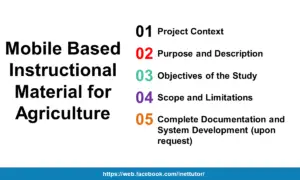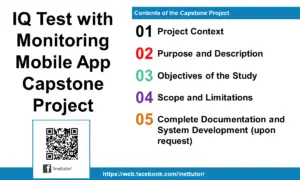Mobile Nutrition App with Admin Panel Capstone Documentation
CHAPTER 1
INTRODUCTION
The technology revolution particularly in the last couple of decades has had a tremendous impact on people’s lifestyles across the globe. A staggering 7 billion mobile-connected devices, more than the number of people on the planet (Cisco, 2012), allow people to stay connected and informed at all times. Mobile phones have become so indispensable that they are almost an extension of our body and mind. According to the study conducted by the PEW research center, 85% of U.S. adults own a mobile phone and 56% own smartphones. This study further revealed that 19% of smartphone users have tracked their weight, diet, or exercise routine online using apps.
Applications, or apps, are marketed and distributed through major smartphone platforms. Android of Google, iOS of Apple, Blackberry (previously known as RIM or Research in Motion Limited), and Windows Phone Apps+Games Store of Microsoft are some of the major applications stores listed in order of the market share of operating systems for smartphones. Google Play and Apple iTunes store are the global market leaders in applications (apps) stores. As of 2012, Apple iPhone customers downloaded more than 25 billion apps, up from 15 billion in 2011. The Android market reached 10 billion app downloads by mid-2011 (The Official Google Blog, 2011).
This study will discuss whether health/nutrition apps need to be regulated by governing bodies in the field of health, and the need for app developers to follow guidelines of health professionals for better quality and delivery of health care. High-quality apps that are designed according to the suggested guidelines backed by health-accredited organizations are more likely to benefit individual users and ensure quality of health care information delivered through smartphones. The results and recommendations of this study are likely to be of interest to health researchers, technology developers, software designers, and policy makers who work in the field of mobile health/nutrition applications.
PROJECT CONTEXT
According to a recent study, people on average spend more time using mobile applications than browsing the Web. This study reported that adults spend twenty-seven hours per month accessing the Internet via desktop; on the other hand, they spend thirty-four hours per month using the Internet on their smartphone. The considerable difference in time spent on the desktop versus mobile phone is mainly because of innovations in the smartphone sector. Also, the usage of apps accounted for 86% of the smartphone Internet time, indicating that people are spending more time with their apps.
Globally, around 4.5% of all searches on the Internet are for health-related information (Eysenbach, & Köhler, 2003). According to the PEW Internet and American Life Project, 72% of American adult Internet users searched for health information online, and of these, 77% said that their search inquiries for health started from major search engines . These figures imply that the Internet has become an important source for consumers seeking health information and health-care services online (Eysenbach, Powell, Kuss, & Sa, 2002). The flip side of this easy availability of health information is that it can be overwhelming for the users. Studies have shown that many adults have difficulty using and understanding online health information, and people with low literacy levels have more trouble comprehending and using health care.
Being healthy involves getting the right amounts of exercise and sleep, as well as eating a balanced diet. But what does a balanced diet look like? A healthy, balanced diet should generally include:
- lots of fruits, vegetables, and whole grains
- low-fat or nonfat dairy
- lean meat, poultry, fish, soy, nuts, beans, and eggs
- limited trans fats, saturated fat, salt, cholesterol, and added sugars
- healthy fat options such as olives, olive oil, and seeds
When eating healthfully, it can be hard to keep up with everything, especially if you’re trying to stick to a specific nutrition plan. We the researchers proposed the nutrition app (web and mobile) to help you start or maintain a healthy diet
OBJECTIVES OF THE STUDY
The aim of this study is to design and develop a web and android application that focuses on health and nutrition topics
Specifically the project will be able to:
- Administrator (web module) will be able to post news, content and tips about health and nutrition.
- Android users will be able to view the news, content and tips provided by the admin.
- The android app has its own local or built-in content (no internet connection is required).
- The android app has a quiz feature that will test the knowledge of the user about health and nutrition.
SCOPE OF THE STUDY
The design and development of the project shall be composed of two parts, the web module which will be developed using PHP, MySQL and Bootstrap and the mobile or android version will be develop using HTML, CSS, JS and Apache Cordova.
In the part of mobile or android users, internet connection is required in order to access the news, updates and other contents provided by the admin. The built-in quiz and other content can be accessed without internet connection. The functional limitation is that, the user or android users to be specific can’t access the web or admin module, whereas the administrator has all the rights to modify and manage the contents such as news, tips, etc.
The mobile version is intended only for android users
SIGNIFICANCE OF THE STUDY
The proposed project will be beneficial to the following:
Instructor (health/nutrition): the outcome of this project can be used by the instructors as their additional learning materials for their students.
Health conscious/Other persons: this will provide convenience to persons who wants to learn about nutrition and other related health topics by just using their android phones.
Other Researchers: The project serves as another source of information for other researchers. It could be a great help for them in analyzing, interpreting and gives them an idea in investigating study regarding mobile or android development.
Researchers: This study will give the researchers the opportunity to further develop their skills in system design and development.
CHAPTER 2
RELATED LITERATURE / STUDIES
mHealth
The advent of personal computers, the Internet, and mobile phones has helped in the innovative and inventive approaches to address the health issues in our society using technology (West, 2013). People are increasingly using mobile technology to monitor their chronic conditions with the help of apps (Ristau, Yang, & White, 2013), and health-care professionals are also tapping their smartphones for crucial health information in clinical practice (Pandey, Hasan, Dubey, & Sarangi, 2013). Online support group intervention has helped individuals to lose weight (Webber, Tate, & Quintiliaini, 2008), and text-messaging interventions have been implemented to facilitate smoking cessation (Obermayer, Riley, Asif, & Jean-Mary, 2004). Clinicians use mobile apps to monitor heart patients (Scherr, Zweiker, Kollmann, Kastner, Schreier, & Fruhwald, 2006), and patients use apps to track physical activities (Consolvo et., 2008). A growing number of health-care professionals and health consumers depend on technology for various issues, including public policy, research, and service (Adams & Leath, 2008).
On-line personal health records management platform
There are three major on-line Personal Health Records (PHRs) management platform in the market: Dossia [31], Microsoft HealthVault [32] and Google Health [33]. These systems allow users to store and manage the health information in one central place. But the disadvantage is that they provide a limited health records formats. For example, only the test results like Glucose levels and blood pressures could be stored into them and the exercise data like heart rate, breathing rate, skin temperature could not be stored into them. By using Google sheet, the user could store any data with various data formats. And it is easier to export the data into a trusted third-party health care system for analysis purpose. Also, user could make a decision to share the profile with other family members or health care providers. It also provides Google sheet APIs for the developer so that it can integrate with the applications with Google sheet.
eHealth
eHealth is the adopted term that is used to characterize not only “Internet medicine” but also virtually everything related to computers and medicine (Eysenbach, 2001). Electronic health (eHealth) applications refer to software apps that present tools and communication means to establish electronic health-care practices (Liu, Zhu, Holroyd, & Seng, 2011). Eysenbach (2001) goes on to add that eHealth is not just about technological innovation: it is at the crossroads of diverse disciplines that are promoting growth of this society.
He characterizes eHealth as:
“an emerging field in the intersection of medical informatics, public health and business, referring to health services and information delivered or enhanced through the Internet and related technologies. In a broader sense, the term characterizes not only a technical development, but also a state of mind, a way of thinking, an attitude, and a commitment for networked, global thinking, to improve health care locally, regionally, and worldwide by using information and communication technology.” (Eysenbach, 2001,p. 20)
With the recent growth in the hardware capacity of smartphones, eHealth capabilities are now accessible from mobile platforms, making mobile health (mHealth) applications an important component of eHealth (Liu et al., 2011). mHealth is defined as the use of mobile devices for communicating health information and health services (Akter, D’Ambra, & Ray, 2011). Mobile phone health intervention is considered to be better than eHealth because people access the Internet through cell phones at any time and at any place (Rosen, Sanne, Collier, & Simon, 2005). Also, fewer skills are needed to use the features of mobile phones than those needed for computers or the Internet (Kaplan, 2006). The mobile platform is sought for health intervention because of its portability, economical feasibility, powerful technical capabilities (Rainie, 2010), the existing dependency on mobile phones (Venta, Isomursu, Ahtinen, & Ramiah, 2008), and context-aware sensing features for timely health interventions (Intille, 2004). The United Nations Foundation in its report on mobile health grouped the usefulness of
mHealth in six categories:
- Education, awareness, and health promotion
- Diagnostic and treatment support
iii. Communication and training for health care workers
- Disease and epidemic outbreak tracking
- Remote monitoring
- Data collection (Vital Wave Consulting, 2009)
mHealth programs and initiatives are implemented in many parts of the world. Text messaging programs, in particular, are popular both in developed countries such as the United Kingdom, Norway, and New Zealand (Whittaker, Borland, Bullen, Lin, McRobbie, & Rodgers, 2009) and developing countries like India, South Africa, Uganda, Peru, and Rwanda (Vital Wave Consulting, 2009). Text messaging interventions have shown effective health behavior change in the areas of smoking cessation, weight loss, diabetes management, and physical activity (Whittaker et al., 2009; Cole-Lewis & Kershaw, 2010). Unlike text messaging, the use ofsmartphone apps for health promotion appears to be rare in developing countries, because of the low penetration of smartphones (Yadav, Naik, Singh, Singh, & Chandra, 2012). Despite its wide use and appeal, phone intervention is still not ubiquitous on a global scale because of limited access to smartphones by people living in remote parts of the world, the elderly, and the poor(Lenhart, 2010).
In a study evaluating the role of mobile health technology, the authors predict that mobile health will have a significant impact in the delivery of health care: Creative use of new mobile health information and sensing technologies (mHealth) has the potential to reduce the cost of health care and improve health research and outcomes. These technologies can support continuous health monitoring at both the individual and population level, encourage healthy behaviors to prevent or reduce health problems,
support chronic disease self-management, enhance provider knowledge, reduce the number of healthcare visits, and provide personalized, localized, and on-demand interventions in ways previously unimaginable. (Kumar, Nilsen, Abernethy, Atienza, Patrick, Pavel, & Swendeman, 2013, p. 232) There are many studies that have evaluated web-based electronic health apps, but the evaluation of mHealth apps has been minimal (Brown, Chetty, Grimes, & Harmon, 2013). Researchers who have assessed and evaluated mobile health technology suggest that mHealth is promising and has great potential to improve health care and health education for the public (Liuet al., 2011), but health interventions must be appropriately designed and tested for target users(Wolf, Akilov, Patton, English, Ho, & Ferris, 2013). Studies have also shown that many apps had problems like small text, poor color contrast, and connectivity issues (Brown et al., 2013; Boulos, Wheeler, Tavares, & Jones, 2011). In a startling find, a study points out that 95% of mobile health apps for consumers are not created on thorough research or properly tested for quality assurance (Bryant, 2012). The present state of mHealth apps highlights the need to gear up research in this field (Krishna, Boren, & Balas, 2009) and encourage IT designers to enhance usability and focus on evidence-based content in their apps for better engagement and credible health outcomes.
CONCEPTUAL FRAMEWORK (I-P-O)
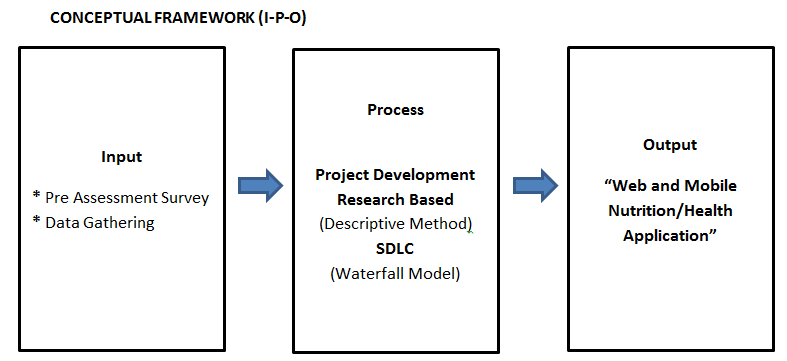
This is the IPO model of the proposed application. The proponents will first gather enough information needed for the development of the app, the data gathered will then be processed, this is where the design and coding phase. The end result of the study is a functional web and mobile nutrition/health app.
DEFINITION OF TERMS
Apache Cordova
Apache Cordova (formerly PhoneGap) is a popular mobile application development framework originally created by Nitobi. Adobe Systems purchased Nitobi in 2011, rebranded it as PhoneGap, and later released an open source version of the software called Apache Cordova. Apache Cordova enables software programmers to build applications for mobile devices using CSS3, HTML5, and JavaScript instead of relying on platform-specific APIs like those in Android, iOS, or Windows Phone. It enables wrapping up of CSS, HTML, and JavaScript code depending upon the platform of the device.
Bootstrap
Bootstrap is a free and open-source front-end web framework for designing websites and web applications. It contains HTML- and CSS-based design templates for typography, forms, buttons, navigation and other interface components, as well as optional JavaScript extensions. Unlike many web frameworks, it concerns itself with front-end development only.
Android Platform
Android is a mobile operating system developed by Google, based on the Linux kernel and designed primarily for touchscreen mobile devices such as smartphones and tablets. Android’s user interface is mainly based on direct manipulation, using touch gestures that loosely correspond to real-world actions, such as swiping, tapping and pinching, to manipulate on-screen objects, along with a virtual keyboard for text input. In addition to touchscreen devices, Google has further developed Android TV for televisions, Android Auto for cars, and Android Wear for wrist watches, each with a specialized user interface. Variants of Android are also used on notebooks, game consoles, digital cameras, and other electronics.
CHAPTER 3 – PROJECT DESIGN
SENARIO BASED (USE CASE DIAGRAM)
A use case diagram at its simplest is a representation of a user’s interaction with the system that shows the relationship between the user and the different use cases in which the user is involved. A use case diagram can identify the different types of users of a system and the different use cases and will often be accompanied by other types of diagrams as well.
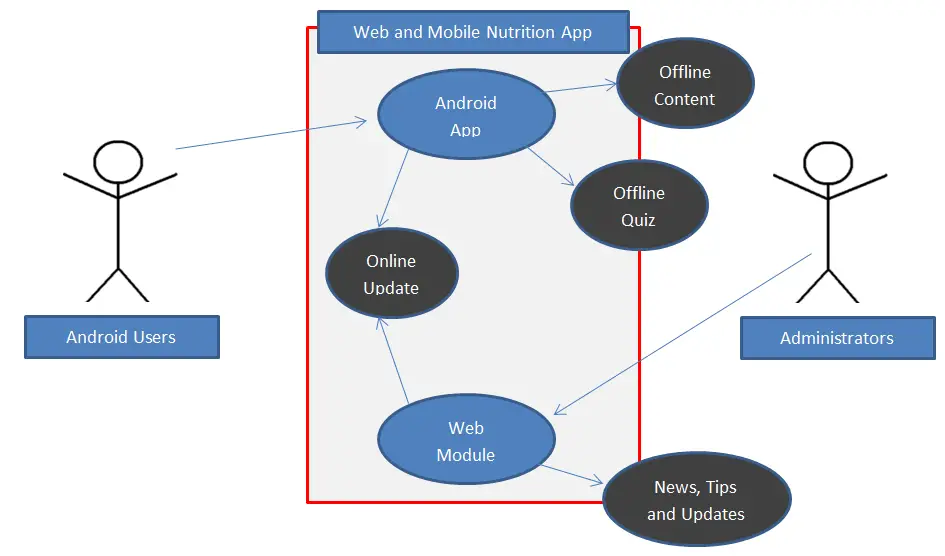
BEHAVIORAL MODEL (ACTIVITY DIAGRAM)
Activity diagrams are graphical representations of workflows of stepwise activities and actions with support for choice, iteration and concurrency. In the Unified Modeling Language, activity diagrams are intended to model both computational and organizational processes (i.e. workflows). Activity diagrams show the overall flow of control.
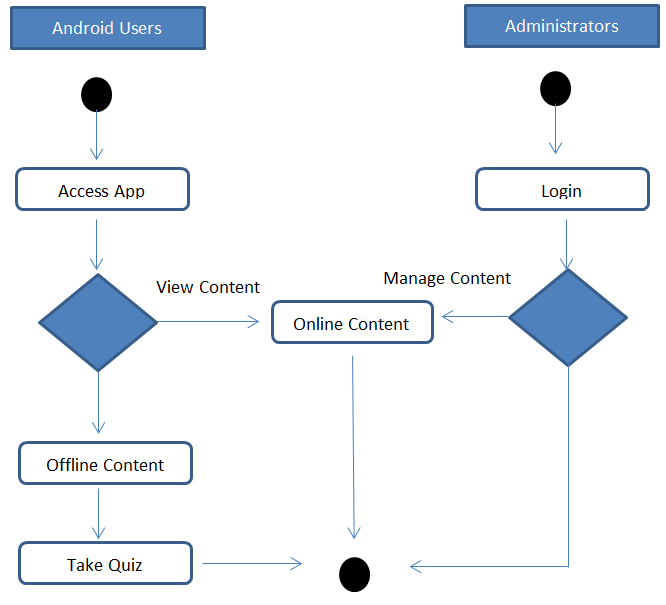
CLASS MODEL
In software engineering, a class diagram in the Unified Modeling Language (UML) is a type of static structure diagram that describes the structure of a system by showing the system’s classes, their attributes, operations (or methods), and the relationships among objects.
The class diagram is the main building block of object-oriented modelling. It is used both for general conceptual modelling of the systematics of the application, and for detailed modelling translating the models into programming code. Class diagrams can also be used for data modeling. The classes in a class diagram represent both the main elements, interactions in the application, and the classes to be programmed.
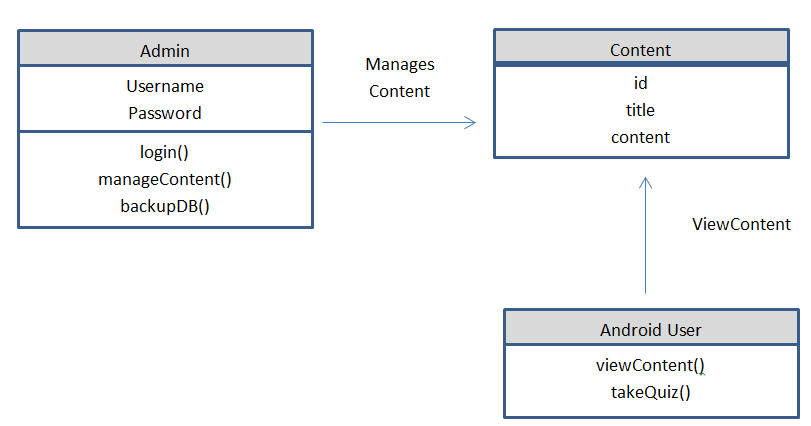
FLOW MODEL (DATA FLOW DIAGRAM)
A data flow diagram (DFD) is a graphical representation of the “flow” of data through an information system, modeling its process aspects. A DFD is often used as a preliminary step to create an overview of the system, which can later be elaborated. DFDs can also be used for the visualization of data processing (structured design).

PROJECT DEVELOPMENT
DESCRIPTIVE METHOD
In gathering important and relevant information, the researchers will use a descriptive method of research which will be useful in this study.
Descriptive method of research is the most commonly used research design and the basic reason for carrying out descriptive research is to identify the cause of something that is happening (http://www.marketresearchworld.net, September 29,2009).
Descriptive research is used to obtain information concerning the current status of the phenomena to describe” what exist” with respect to variables or conditions in a situation(http:/www.okstate.edu,October 1,2009) and through this method of research the researchers will enable to describe the effect/usefulness of a web and mobile health/nutrition app.
TESTING PROCEDURE / EVALUATION PROCEDURES
Test Plan
The system will undergone the three testing which are the Initial Testing, Final Testing and User Acceptance. During the initial testing and final testing, three IT Experts will test the system, they will measure whether the system met the user requirements and also the functionalities. The systems criteria were based on McCalls Software Quality Model to evaluate the quality of the System.
User Acceptance testing is an evaluation to test whether the end user are convinced and satisfied to the functionality of the system. Students was evaluated the system based on the validated questionnaire.
